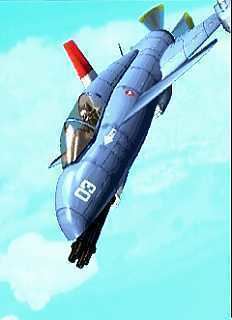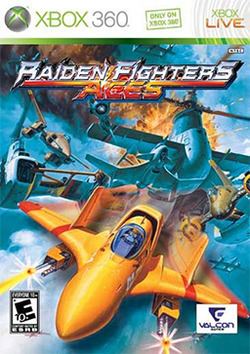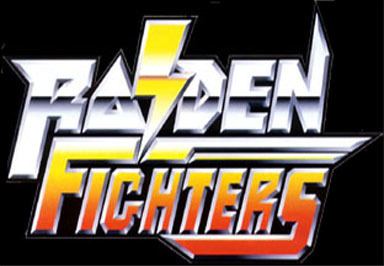 | ||
Games Raiden Fighters Aces, Raiden Fighters Jet, Raiden Fighters 2, Raiden Fighters | ||
The Raiden Fighters (ライデンファイターズ, Raiden Faitāzu) series is a popular series of top-down vertically scrolling shoot 'em ups for the arcades by Seibu Kaihatsu. It is a spinoff of the original Raiden series. The games were initially distributed in Japan, and were later picked up by international distributors such as the now-defunct Fabtek in the United States, Tuning Electronic in Germany, and The Metrotainment Network and Dream Island in Asia.
Contents
- History
- Series overview
- Level Structure
- Power Ups
- Charged Specials
- Slaves
- Large Roster of Fighter Craft
- Hidden Fighter Craft
- Small Hitboxes
- Sniper Enemies
- Boss Behavior
- Scoring System
- Medal System
- Bonus Scoring Opportunities
- Bullet Scratching
- Ports and conversions
- References

The series began with the first game, titled Raiden Fighters, released in 1996. It was followed by two sequels: Raiden Fighters 2: Operation Hell Dive (1997) and Raiden Fighters Jet (1998). It took until the year 2008, a full decade after the release of Raiden Fighters Jet, for any of the games to be ported to a home video game console.

History
A common belief is that the Raiden Fighters series is part of the original Raiden series. During the first Raiden Fighters' development, it went by the tentative working title of Gun Dogs. Seibu Kaihatsu changed the name to Raiden Fighters before its release. In pre-release market tests, Seibu Kaihatsu discovered that people paid more attention to the game when it had the word Raiden in its name. Two cameo ships from Seibu Kaihatsu's popular vertical-scrolling shooter games, including the mascot ship from main Raiden series, were added to coincide with the name change. There were originally only the five standard aircraft in the first game.
The remnants of this tentative game name can still be seen in several forms in the final Raiden Fighters game.
Series overview
The general gameplay of the Raiden Fighters series is similar to the original Raiden series. It introduces several new elements of gameplay not present in the original series. Like most games in the scrolling shooter genre, games in the Raiden Fighters series have simplistic controls. An 8-way joystick moves the player's craft around the playfield. A Fire button shoots the player craft's weaponry. A Bomb button unleashes an attack that inflicts serious damage against enemy targets and cancels out enemy fire caught in its blast.
The difficulty dynamically adjusts itself, taking into account how many power-ups collected and how long players survive between lives. This mechanism is referred to as rank. As the rank increases, enemies will fire more bullets, and they will travel faster. If players lose lives, the enemies and bosses will attack less aggressively, effectively dropping the game rank.
Level Structure
The Raiden Fighters series introduces a partially non-linear level structure. The first two games have seven levels each. These seven levels are arranged into three Missions. The first two Missions have three levels each: two randomly ordered short levels (lasting about one minute in length before the boss encounter) ending with a long boss level, which involves making strikes against different parts of the boss, and lasts between three and four minutes. The final Mission in both of the first two games is a lengthy approach over the main enemy base.
Raiden Fighters Jet's level structure is even less linear. Progression is governed by how well a player performs in a given level, and each level path gives a different end-game sequence. Players can never play through all levels available in Raiden Fighters Jet in one play session.
Power-Ups
Extraneous pick-ups of the "L" and "M" icons add 5,000 points to the player's score. The Laser and Missile weapons cannot be equipped at the same time; if one is picked up, the other is disabled in lieu of the new weapon. Collecting multiple L's or M's will increase the power of the weapon.
The cameo ships from Raiden II and Viper Phase 1 can utilize both Laser and Missile weapons simultaneously. However, each needs to be powered up individually.
Charged Specials
All standard fighter craft have this capability. A charged special is a powerful attack that can inflict significant damage on any hostile target. Charged specials are available for both Laser and Missile weapons, giving each craft two different variations of these attacks.
Slaves
In the Raiden Fighters series, a Slave is a drone wingman that accompanies the player's craft, providing additional firepower, as well as protection from enemy fire. Players can have up to two Slave wingmen at one time. When players perform a charged special attack, their Slaves assume one of four different attack formations for the duration of that charged special. Slaves have more resilient armor than the player's own fighter craft; they can withstand multiple direct hits from enemy fire before being destroyed.
Large Roster of Fighter Craft
The most significant new element is a wide selection of fighter craft available for players to select. Each craft has differing attributes:
All standard fighter craft possess a primary weapon, which is a vulcan gun. They are equipped with two secondary weapons, a Laser weapon and a Missile weapon, made usable by collecting the appropriate power-up items. Only one secondary weapon can be active at a time. Each secondary weapon has four levels of power.
Hidden Fighter Craft
A notable feature is the inclusion of hidden fighter craft in all three games. These secret craft are made available by software settings or when other special requirements are met.
All three games include two ships from Seibu Kaihatsu's past hit games as cameos among the hidden craft: the mascot ship Raiden mk-II from Raiden II and the red player ship (given the name of Judge Spear in the Raiden Fighters series) from Viper Phase 1. The cameo ships begin with a stock of three Bombs (opposed to two Bombs for the other standard craft). The two ships use the same bombs they used in their original games. The cameo ships use the same Slave machines as the standard craft. The Slaves for the two secret ships will assume different formations when a Slave icon is collected when they already have two Slaves accompanying them.
The Raiden mk-II and the Judge Spear do not have charged specials. They can use both Missile and Laser weapons simultaneously. However, each needs to be powered up individually.
The Slave is also a hidden fighter craft in all three games. The Slave of any craft is playable. It has a rapid-firing, increasingly spreading, and highly damaging main weapon that requires just four power-ups to reach full power. A Slave inherits the speed and the Bomb of the fighter they normally accompany. The most significant aspect of the Slave is its very small hitbox.
Small Hitboxes
Hitbox sizes vary widely between different fighter craft. A particular hidden fighter craft, the Slave, has the smallest hitbox out of all available craft.
Sniper Enemies
An enemy trait carried over from the original Raiden series is the sniper enemy, which is a usually small enemy that appears suddenly at the player's most vulnerable sides, firing at the player almost immediately. This surprise attack usually catches players off-guard, resulting in being shot down. The sniper enemy is considered to be an aggravating nuisance to most players.
In the Raiden Fighters series, sniper enemies are exclusively tanks. These tanks make delayed appearances onto the playfield, at times coming into view at the bottom half of the playfield, making for a surprise flank attack on the player. Some make sudden appearances during boss battles and even among usual Medal cache locations.
Boss Behavior
All bosses in the games have two forms of attack. Bosses initiate their second form of attack after suffering enough damage. Bosses will self-destruct after a set amount of time, releasing a final fast all-directional burst of bullets to spite the player before its destruction.
Scoring System
Scoring in the Raiden Fighters series is straightforward. An end-of-mission bonus is assessed after defeating the bosses in the long boss stages in the first two games, taking into account the percentage of the boss hardpoints and other specified targets destroyed, as well as the number of medals collected. The scoring system was given significant changes in Raiden Fighters Jet.
Medal System
Medals appear far more frequently in this game series than in the original series. Additionally, their point values can be increased in various ways. A majority of the player's score can be attributed to medal pickups alone.
Medals can be worth up to 100,000 points each after completing special requirements. A penalty is assessed when a player allows a medal to leave the playfield in any fashion. In the event of this occurrence, future gold medals released are reset to 10,000 points. However, players can recover their gold medal values if at least one higher-valued gold medal still remains on the playfield, and that medal is the last visible medal to be collected.
The medal system was modified significantly in Raiden Fighters Jet.
Bonus Scoring Opportunities
Many bonus scoring opportunities exist in all three games of the series. The following are bonuses common to all three games:
Each game has specific bonuses in addition to those aforementioned.
Bullet Scratching
Also referred to as grazing, buzzing, or scraping, this technique is also found in later scrolling shooters such as Castle Shikigami 2. Enemy bullets that overlap a player craft without coming into contact with its hitbox will grant the player additional score. Some enemy attack patterns are designed so that this technique can be exploited by daring players as a scoring opportunity.
Ports and conversions
Early porting attempts of these games to home video game consoles had been canceled.
The first porting attempt was in 1997, with the first Raiden Fighters for the Sega Saturn, developed by Victor EA of Japan. The Saturn port was canceled for an unknown reason.
In 2003, a now-defunct Japanese company, New World System, was working on ports of Raiden Fighters and Raiden Fighters 2 for the Xbox and PC under the name of Raiden Fighters Evolution. This port was canceled when New World System went out of business.
On November 21, 2007, Japanese video game magazine Famitsu reported the development of a compilation of all three Raiden Fighters games for the Xbox 360. This compilation is titled Raiden Fighters Aces, published by Japanese software company Success Corporation and released on March 27, 2008. The release of Raiden Fighters Aces brings to an end a decade-long drought for any of the games to finally appear in the home console market.
It has also been developed for the iOS under the name Raiden Legacy.
